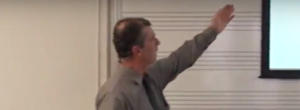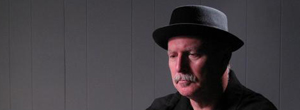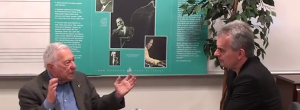by Chet Williamson
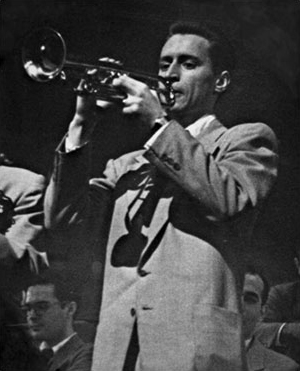
NAME: Donald Alton Fagerquist
DOB: February 6, 1927, Worcester, MA
DOD: January 23, 1974, Canoga Park, Los Angeles, CA
Parents: Bernard Alex Fagerquist (1891-1982) and Florence I. Moran (died in 1975)
Instrument: Trumpet
Education: Worcester Public Schools, North High School
Private Instruction: Ms. Marion Twiss at Roosevelt Elementary and lessons at Carl Seder's Music in Worcester
Worcester playing experience: Paul Rhode, Paul Gervais, Bud Boyce and the Ambassadors/Crusaders (1940), the Dol Brissette orchestra (1941) and the Bob Pooley Band (1942).
Playing experience: Mal Hallett (1943), Gene Krupa (1944-'49), Artie Shaw (1949-'50, Woody Herman (1951-'52), Les Brown, Dave Pell (1953-59), staff musician at Paramount Studios (1956-66), freelance with Pete Rugolo, Mel Torme, Louie Bellson, and Laurindo Almeida, among others (1966-74).
Select Discography: Fagerquist played on more than 200 albums including, Concert at the Palladium, Les Brown; Gallery of the Seldom Heard Tunes by Irving Berlin, Dave Pell; Out on a Limb, Pete Rugolo; Benny Goodman, Buddy DeFranco; West Coast vs. East Coast, Leonard Feather's Stars; Ole Bossa Nova, Laurindo Almeida; All of Me, Benny Carter; Torme Sings Astaire, Mel Torme.
Discography as a leader: Music to Fill a Void, Eight by Eight
Backed and recorded with such premier artists as: Charlie Parker, Art Pepper, Chet Baker, Roy Eldridge, Harry "Sweets" Edison, Stan Kenton, Herb Geller, Hal McKusick, Conte Condoli, Buddy DeFranco, Shelly Manne, Ray Brown, Tommy Dorsey, Gerry Mulligan, and Benny Goodman, among many others. See:
Backed and recorded with such esteemed singers as: Nancy Wilson, Ella Fitzgerald, Mel Torme, Bobby Darin, Peggy Lee, Frank Sinatra, Rosemary Clooney, Anita O'Day, Lena Horne, Della Reese, June Christy, Sarah Vaughan, the Hi-Lo's, Ann Margaret, Patty Page, Billy Eckstine, and Hendricks, Lambert and Ross.
Played on such seminal albums as: Ring-A-Ding-Ding! Frank Sinatra; Ella Swings Lightly, Ella Fitzgerald; Art Pepper plays Shorty Rogers and others, Art Pepper; Hoagy Charmichael, Hoagy Sings Charmichael; Pacific Jazz Years, Chet Baker; Sings the Irving Berlin Songbook; Ella Fitzgerald; and Bird with the Herd, Charlie Parker.
Played on such memorable singles as: Opus #One with Gene Krupa, In the Wee Small Hours by Frank Sinatra, As Long As She Needs Me by Sammy Davis, Jr., Mr. Lucky by Henry Mancini, Fever, Peggy Lee; and Baby, It's Cold Outside, Ray Charles and Betty Carter.
Television: Fagerquist played on nearly 200 shows including, The Joey Bishop Show, The Danny Kay Show, Dick Van Dyke, Gomer Pyle, Hogan's Heroes, Andy Williams, I Spy, Smothers Brothers, Daktari, Red Skelton, The Jack Benny Show, and The Carol Burnett show.
Select Television Shows: "Stars of Jazz" (1958), "The M-Squad," starring Lee Marvin (1957-1960).;"Startime," Episode: The Swingin' Singin' Years, hosted by Ronald Reagan (1960); "The Andy Griffin Show" (1960), "Braddock" (1966); "The Tom Kennedy Show" (1974) with Dave Pell, Jimmy Rowles, Ray Brown, and Frank Capp.
Documentary: The James Dean Story, featuring Chet Baker, Bud Shank and Charlie Mariano
Select Filmography: Fagerquist played on more than 150 Hollywood film soundtracks, including George White's Scandals (1945), Make Believe Ballroom (1948), Way � Way Out (1966, scored by Lalo Schifrin), Desire Under the Elms (1958), Johnny Cool, starring Henry Sliva and Elizabeth Montgomery (1960).
Press quotes: "Instrumental jazz, with all of its departmentalism, is forever rooted in the fundamentals of pronounced rhythm and emotional interpretation. In this tradition, Don Fagerquist ranks close to the 10 or 12 trumpet stylists who have broadened its scope in jazz. His musical democracy is on display, firmly supported by eight aggressive believers." � from the liner notes to Music to Fill a Void, Fagerquist's only album as a leader, written by Joe Quinn
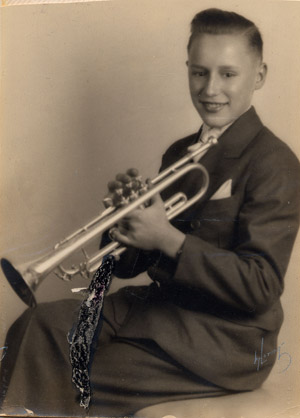
We called him Donny
Among the many shining trumpeters to hail from Worcester, Don Fagerquist is one the brightest stars in the entire jazz constellation.
He started as a child and by the time he was 13 could be found playing professionally in many of the city's best bands. At 16, he quit school to take a spot in the trumpet section of Mal Hallett Orchestra, a territory band that barnstormed throughout the East Coast.
At 17, Fagerquist went national when recruited by Gene Krupa. From there, he became a star soloist with Artie Shaw, Woody Herman, Les Brown, Dave Pell, and at Paramount Film Studios in Hollywood. He died of kidney disease on January 24, 1974, at his home in California. He was only 46.
In his lifetime, he was a vastly underrated jazz trumpeter who played on more than 200 albums and more than 100 films. However, today his musical legacy as an artist continues to be touted by the many young musicians who both admire his trumpet mastery and push for a new critical reassessment of his work.
Worcester
Fagerquist was born in the city on February 6, 1927 and grew up in a musical family of three children on a dead end street at the southern slope of Grafton Hill at 4 Pocasset Street in Worcester, MA. Don had two brothers, Richard and Andrew, and a sister, Evelyn. His mother (Florence Moran) played piano and his dad (Bernard Axel Fagerquist) liked to toot on the harmonica when not working at Norton Company.
According to his older sister Evelyn (Bowler), young Donny was given his first trumpet at 5 or 6 years old. It was a Conn New Symphony (Note: Towards the end of his career he would play a Calicchio-designed horn).
"I don't know whether they invested in it or whether it was loaned to him," Don's sister said. "[My parents] must have bought it. I guess my mother pushed him, but they liked the fact that he played. When Donny was young he had like 'curvature of the spine.' He had problems with his shoulder. They wanted him to stand up straight."
Don's sister also reported that the family was told that music lessons would help. In fact, blowing the trumpet would help him. "So I guess that's how he got started," she said. "It did help him. He turned out fine. I think it may have kept him out of the army.
"There was always music in the house. Of course my mother used to play the piano a lot and [Donny] would stand there and play with her when he was small. My mother liked the old songs, some of the old ragtime stuff -- all those musicals. I remember we would go to the movies. There was nothing else to do in those days. I think I saw every musical there was.
"I think [Donny] used to diddle around with the piano as well. My mother taught herself. She said when she was young her folks couldn't afford a piano so they rented one for a while and she taught herself. She got the books and everything. She started making the chords. She enjoyed making up her own chords."
She also mentioned that young Donny took his first lessons with Ms. Marion Twiss at Roosevelt Elementary School. "She was the music teacher. She was the one that first noticed that he had talent."
Fagerquist would later take lessons at Carl Seder's Music Mart in downtown Worcester, but he was essentially a self-taught, jazz trumpeter, who learned the old fashion way: by his mentors on the bandstand.
Also someone to notice his talent was June Fagerquist, a sister-in-law, who was married to Don's older brother Andrew. "I knew him when he was just a little boy," she said. Now in her 90s, the sister-in-law recalled being astounded by young Donny's musical ear. "He had perfect pitch," she said. "One day I walked over to the piano. I hit a note and without looking, he said, 'That is a C.'"
According the young trumpeter's older sister, Evelyn, he began playing his first performances at local churches and gigs with neighborhood friends while still in grade school. "There was Paul Rhode [who also worked with drummer Frank Capp]. He was a good friend of Don's. There were four or five of them. They all chummed together," she said.
In 1940, at the age of 13, Fagerquist began work with Bud Boyce and the Ambassadors (also known as the Crusaders), which was possible a Holy Cross-based band. In 1941, he played in trumpet section of the Dol Brissette Orchestra, the house band at radio station WTAG, the NBC affiliate located in on Franklin Street in Worcester.
According drummer Ed Shamgochian, the all-white society bands like the Brissette ensemble were called, "downtown bands" and the radio gig was a good one.
"Musicians had it made," he said. "I think we made three bucks. Pete Clemente and George Gregory were in that band. Emil Haddad was in the band. Good trumpet players. We worked the radio station all week a long and at the Bancroft Hotel for dinner and dancing."
The following year, in addition to playing in the school band at North High School, Fagerquist began working with a band led by trumpeter Bob Pooley.
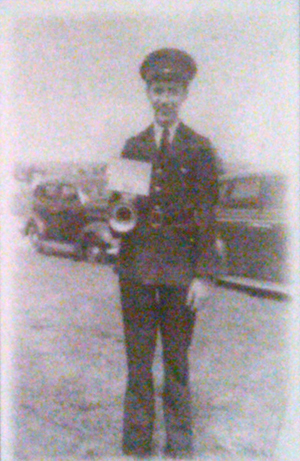
"[It] was a great band," said Shamgochian. "The book was written by Murray Guarlnick. We played at Hampton Beach at the Casino. That was a big thing. We packed that house."
According to Shamgochian the group was asked to tour and be showcased at Maria Kramer's Blue Room at Hotel Lincoln, New York City, but as he said, the group consisted mainly of 16 to 18 year-old kids. "All the mothers were calling each other and there was a little revolt from going on the road," he said, laughing.
Mal Hallett (1943)
In 1943, Fagerquist got the break that would take him out of town, joining the Boston-based Mal Hallett Band, a regional group that began in the roaring 1920s.
"There was this place down in Westboro, the Moors," said Donny's sister Evelyn. "That's where someone heard him playing and Mal Hallett signed him up. My mother didn't want to let him go. You want them to be successful and yet you hate to see them leave."
Largely forgotten today, it was highly regard in its time. Playing a winning combination of novelty tunes with tight orchestrations, the group was known for wowing audiences. No less than Duke Ellington has been quoted as stating: "All these bands used to come up from New York, and Mal Hallett would blow them right out over the Charles River."
And, as historian George T. Simon wrote this of Hallett: "Musicians liked and respected him. He gave them opportunities to play good music, even before [Benny] Goodman made it fashionable."
In addition to Fagerquist, among the many musicians to pass through the ranks of the band were such local stars as Boots Mussulli and Emil Haddad. Others notables include: Jack Teagarden, Toots Mondello, Frankie Carle, Turk Murphy, singer Teddy Grace and drummer Gene Krupa.
Gene Krupa (1944�'49)
In 1944, Fagerquist turned 17. It was a monumental year for the teenager. Not only did he join the Gene Krupa band, he married 18 year-old Margaret June O'Brien from Amesbury. The couple met while the young trumpeter was playing in the Pooley Band at the Hampton Beach Casino. See: WPI interview with Shamgochian.
Fagerquist joined the Gene Krupa Band one year after the drummer's infamous arrest for marijuana and the bandleader had a renewed commitment to the music. However, the first comeback band was a short-lived venture. It was known as the "Band That Swings with Strings."
According to Burt Korall and Mel Torme in their book, Drummin' Men: The Heartbeat of Jazz, the band would shortly prove to be both a heavy financial burden and unwieldy for the drummer's musical energy and sensibilities. Krupa was ready for something new and after completing the filming of George White's Scandals for RKO Pictures, the drummer made some radical changes.
He formed a new band and gave it new music -- bebop. In speaking about the change, Krupa said: "I was attracted by the new jazz. After listening to Dizzy [Gillespie] and Bird [Charlie Parker] for a while, I began to hear music differently. It wasn't too long before I made a commitment to this music. I hired Gerry Mulligan. An original arranger who was deeply involved with what was happening, he brought in a number of excellent charts, including, 'Disc Jockey Jump.'"
Krupa also hired young firebrands who embraced the new sound.
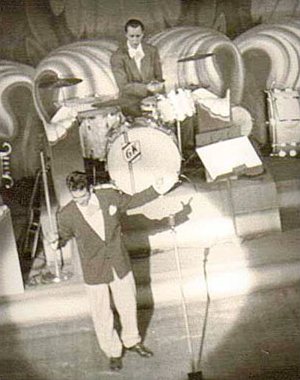
"My old friend Mal Hallett was a key source for our venture into modernism," Krupa said. "He sent me tenor saxophonist Buddy Wise, trumpeter Don Fagerquist, and trombonist Dick Taylor, the nucleus of this contemporary band. Young Red Rodney, a terrifically talent trumpeter, alto saxophonist Charlie Kennedy, and Charlie Ventura, our star tenor man also shaped the concept of the organization."
Krupa, of course was a member of Hallet band the year before along with Fagerquist and certainly would have known of his playing ability. According to Korall and Torme, this addition of the band was "clearly the most exploratory" of all of the Krupa bands.
Krupa himself was quoted as saying, "The band sounded wonderful, clean, beautiful, together. We were into adventurous, meaningful music and managed to make it commercially at the same time. The guys in the band kept pushing me to stay on the ball, to keep learning. And I encouraged them to do whatever they felt was musically valuable. I showcased the heavy players. We had a good thing going."
A variety bad luck and trouble put an end to the band (1951). Krupa explained it this way: "Several of my key men left for jobs in the studios, with other bands, or formed their own groups. The replacements didn't fill the bill. Many of these young cats had promise but were into the heroin thing. I soon got tired of playing cop every night."
In Drummin' Men: authors Korall and Mel Torme, quoted Fagerquist addressing Krupa's trials: "He was just trying to make a clean living, but the police would never leave him alone. If some pusher got arrested three states away, he would say, 'Gene Krupa gave it to me,' and Gene would have to take two or three nights off to answer the charges. It must have been degrading for someone in his position."
For Fagerquist the experience with Krupa not only gave him the opportunity to travel the country, play on national radio and television, and the thrilling opportunity to record with Roy Eldridge -- one his idols -- it established him as a player in the major leagues.
Artie Shaw (Big Band, and Gramercy Five 1949�1950)
Fagerquist's next move placed him in heavy company. In 1949 he joined the Artie Shaw bands. It was known as the "money band," because the clarinetist was strapped for cash and the group was formed to raise some greenbacks. Vowing to never again play dance music, the artistically uncompromising Shaw organized one of the finest bands of his career.
According to writer Scott Yanow, Shaw, like Krupa, was influenced by the new music of bop and wanted to incorporate the modern sounds into his music.
"The group (Shaw's sixth and final big band) recorded only six songs in the studios for Decca �. With trumpeter Don Fagerquist, altoist Herbie Stewart and Frank Socolow, Al Cohn (who gets a lot of solo space) and Zoot Sims on tenors, and guitarist Jimmy Raney, this ensemble definitely had potential. They performed updated versions of swing standards and some originals with cool and restrained excitement that sometimes looks a bit towards West Coast jazz, too. Pity that this band did not last," Yanow said.
Formed in New York in August of '49, the band toured first before entering the studio to record. According to John White, author of Artie Shaw: His Life and Music, the band was the clarinetist's, "most progressive and adventurous aggregation." Besides the outstanding players, the band arrangements were supplied by among others, Tadd Dameron, Johnny Mandel, George Russell and Eddie Sauter.
Musically, aesthetically, and artistically speaking the band was perfect. Commercially it was a flop. Author Tom Nolan, in his book Three Chords for Beauty's Sake: The Life of Artie Shaw quoted the bandleader talking about the situation: "If you've got a band that you know is the best band in the state of the art at the time, and the audience is going like this [holding its nose] � you know you're on the wrong track. And that was arguably the best band of its time, I think."
At the same time, Shaw organized a small band to record called, the Gramercy 5, featuring Fagerquist, Raney, pianist Dodo Marmarosa and/or Gil Barrios, bassist Dick Niveson, and drummer Irv Kluger. Although later resurrected with a different personnel, this version only last a few months. It too filled the same artistic bill, but not the commercial criteria of the day.
For Fagerquist, it was yet another stepping stone in his development toward trumpet mastery.
Woody Herman (1951�1952)
When the Shaw banded folded, Fagerquist hitched his trumpet to the newly formed Woody Herman band. It was called the "Third Herd," because it was the third incarnation of Herman's Thundering Herd.
According to Don's daughter, Donna Fagerquist, the family made the move to Hollywood in 1951 and he became a card carrying member of the Professional Musicians Union Local 47 in Los Angeles.
"My brother [Thomas Eric] was born in '46. [My parents] had him on the road with them until he was old enough to start school," Donna said. "They stayed at the Hotel Knickerbocker at first because Dick and Margerie Van Dyke recommended it. The four of them had become friends while staying at some hotel in Chicago, and Margerie stayed at the Knickerbocker while Dick was on the road with his radio show. It was also a block away from Capitol [Records], so they decided it would be a good starting point."
In 1952, the Fagerquists rented a house in Encino, just prior to the birth of their second child, Donna. "My brother started school there," she said. "By '56, a lot of Hollywood people were moving to the San Fernando Valley. Several of his musician friends lived there. So they finally bought a house in Canoga Park, CA."
In 1951 Woody Herman, much like Shaw and virtually every bandleader at what proved to be the end of the big band era, was scuffling. In the autobiography of Woody Herman, The Woodchopper's Ball, ghost writer Stuart Troup quotes Herman saying: "We were in there punching, but we were not doing much better than before. We had more buyers, because we were more dependable for them; our music wasn't as flagrantly 'outside' the mainstream as the Four Brothers Band [referring to Stan Getz, Zoot Sims, Herbie Steward and Serge Chaloff]. We got television shots, including the Ed Sullivan show�
"We had one, two, or more great players in every formation of every band. I tried always to get the best players with the money we had to offer, and at one moment or another in the '50s, we attracted Al Porcino, Bill Berry, and Don Fagerquist on trumpets, Wayne Andre on trombone, drummers Sonny Igoe and Chuck Flores, and bassist Red Kelly, among others."
Dave McKenna, Red Mitchell, Milt Jackson, Carl Fontana, Rolf Ericson, Ed Shaunessey, Urbie Green, Shorty Rogers, Nat Pierce, Chubby Jackson, Al Cohn, Bill Harris, Ernie Royal, Kain Winding and Frank Rehak, and Bill Perkins also passed through the corral of the Herd in this period.
Like all of Herman's bands, this was a freewheeling swinging band also known for its outstanding soloists such as Fagerquist. The band also featured great guest soloists, including the master, Charlie Parker. Thankfully, the meeting has been documented. The album is called, Bird with the Herd. It was recorded live at the Municipal Arena, Kansas City, Missouri on July 22, 1951. The liner notes read: "A historic summit meeting of jazz took place on a scorching summer afternoon in Kansas City when Charlie Parker joined Woody Herman's Third Herd in a series of blazing solos against the background of some of the best Herman repertoire of that period."
Soaring on stage with the "Bird" in flight one can only imagine how Fagerquist felt and the lessons this still young trumpeter gathered as his take away.
Les Brown (1953), and the Dave Pell Octet (1953�1959)
1953 found Fagerquist, the nomadic trumpeter, in yet another musical setting. At this time be was now based in Los Angeles and divided his time between two bands, but also started making inroads into the Hollywood studios.
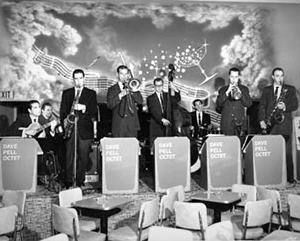
Bandleader Les Brown (and his Band of Renown) was a clarinetist and saxophonist who rarely soloed. According to music writer Donald Clarke, Brown instead hired great players to do the soloing for him. He notes that, "Gunther Schuller has pointed out that Brown had a knack for hiring reedmen who could play well in the higher registers, giving the band a modern sound influenced by Lester Young; good musicians passing through included Abe Most, Zoot Sims, Dave Pell on reeds; Ray Sims (Zoot's brother) and Si Zentner on trombone; Billy Butterfield and Don Fagerquist on trumpets."
A high water mark for Fagerquist with the Brown band can be heard on the 1954 recording Les Brown: Live at the Hollywood Palladium. Fagerquist is prominently featured performing some of his strongest playing to date. That same year, he was chosen the No. 5 trumpeter in the country by Metronome Magazine. Those ahead of him were Chet Baker, Dizzy Gillespie, Shorty Rogers and Roy Eldridge.
According to Dave Pell, Les Brown was not originally a fan of Fagerquist's playing. He wanted the trumpeter to play the same way every night. Years later, after listening to tapes of the Palladium show, Pell claims to have been told by Brown that "Fagerquist was the best."
Fagerquist's stint with the Dave Pell Octet finds the trumpeter at the jazz firmament. His playing is fully realized, brilliant, and showcased in both the ensemble and as a soloist. Much has been written about his tenure with the band, which, fortunately, has been well documented. Fagerquist performed on some 15 albums with the octet.
In addition to his tenor saxophone playing, writing, and arranging, bandleader Pell is also known as a producer who scored hits with Martin Denny and the Ventures. He worked with Fagerquist in the Les Brown band and when organizing his octet Pell says, Don was his first call.
In an interview with music writer Marc Myers, Pell share his thoughts on Fagerquist: "Don came on Les Brown's band in '52. By then he had moved out to the West Coast with his family. He was amazing from the start. He had gotten an incredible education in all those other bands. But I'm not sure in which band he became Don Fagerquist, the great trumpet soloist."
Music writer John Denton in his work West Coast Sounds offers a rather critical assessment of the Dave Pell Octet: "In some ways Pell came to be seen as almost personally responsible for the perception of West Coast jazz as bland, over-arranged and lacking in spirit, and musicians and critics referred to his music as 'Mortgage Paying Jazz,' or 'Grey Flannel Suit Jazz,' and described it as designed not to disturb anyone."
When focusing in on Fagerquist's playing however, Denton writes in praise: [He] surely ought to have been better regarded. His solos, scattered around in 1940s and 1950s Big Band records by Gene Krupa, Woody Herman, Artie Shaw, and Les Brown, were always well shaped as were his contributions to the Pell records on which he appeared. Fagerquist made only one album under his own name at the time of the West Coast boom, but it is worth trying to track it down. Like Pell, he had a taste for good songs and his immaculate work on Smoke Gets In Your Eyes, Easy Living, and All the Things You Are is both imaginative and subtle."
Fagerquist recorded only twice as a leader. In 1955 the trumpeter entered Capitol studios to record an incomplete album. And in 1957, he finished a project for Mode, the masterful Music to Fill a Void.
Continuing with his thoughts on Fagerquist, Pell said, "He played so beautifully and cleanly. Your ear wanted to hear more when he played. With Donny, it was like having a genius on the band. He was a class act. When the arrangers realized what they had in Don, he had solos on every tune. His sound was beautiful. He had chops to do anything he thought of."
In explaining the sound of Fagerquist's trumpet, Pell said, "First of all Don rarely missed anything. Some go for a high F and never get there. Donny could get there and do almost anything that came into his mind. He had a little fatter sound than most trumpeters, and what he played was always hipper. His tone was so full it almost sounded like he was playing flugelhorn. There was roundness there, and no one else had that sound."
Pell also took the time to shed some light on the personal side of Fagerquist. "We called him 'Dugan.' Everyone who liked him called him that," Pell said. (He was also on as Fag � pronounced with a long "a") and he was also known as "Don Fingertwister," because of the beautiful turns he would play.
"Most people don't realize that Don was comedic," Pell told Myers. "He always played something cute and funny. And he was always thinking ahead. He was so fast that he would mock his own initial solo in his second solo. It was incredible. The average listener might not hear what Donny was doing there, but a musician would."
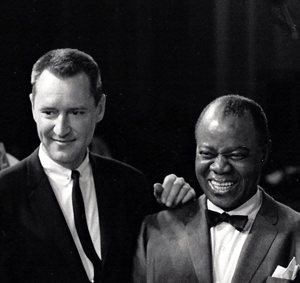
Paramount Film Studios (1956-66)
In 1956, Fagerquist joined the staff of Paramount Film Studios, and from this time forward would become better known for his session playing. Nonetheless, the trumpeter appeared on more than one jazz classic. In fact, throughout the 1960s, Fagerquist appeared on albums by such notables as Pete Rugulo, John Graas, Shelly Manne, Chet Baker, and Art Pepper. He also worked on projects by Frank Comstock, Nelson Riddle, Billy May, Paul Weston, and Si Zentner.
In the early 1960s Paramount produced such programs as The Lucy Show, The Andy Griffin Show, Mission Impossible, and Star Trek. The film production was much deeper. A partial list of film from the decade between '56-66 include such classics as The Rainmaker, The Ten Commandments, Gunfight at O.K. Corral, Funny Face, Vertigo, Lil' Abner, Jack the Ripper, Psycho, G.I. Blues, Breakfast at Tiffany's, Blue Hawaii, The Man Who Shoot Liberty Valance, The Nutty Professor, The Spy Who Came in from the Cold, and Alfie. Fagerquist, conceivably, could have played in the pit band on all of these films.
Last Days in Hollywood (1966-74)
According to Donna Fagerquist, who has books that track all of her father's sessions, the trumpeter played on countless radio, television, jingles, and film recording dates.
"Between 1950 and 1974 -- when he wasn't doing record dates and television specials with people like Sinatra, Torme, Bennett, Clooney, Anita, Ella, Carmen, Eckstine, Horne, Doris Day, Andy Williams and many, many others -- he did literally hundreds of films for Paramount, RKO, Desilu, MGM, Warner Brothers, Universal, and Disney -- as well as hundreds of television shows at these same studios and NBC, CBS, and ABC."
He may have been out of the public eye, but this doesn't mean that Fagerquist was not continuing to play trumpet at a high level of musicianship. Don's daughter Donna would like to set the record straight.
"When you 'Google' my father, or read some biography that some fan or somebody who thinks they're an expert put together, they all make it sound like he went on staff at Paramount and it was the end," she said. "Even Wikipedia claims by 1966 health issues forced him to withdraw from studio recording altogether, and he died in '74.' This stuff couldn't be further from the truth.
"I guess what's important to me, is the fact that my father worked almost every day in the nearly 25 years that he was here in California. He was in high demand. He was among a select list of probably 15 or 20 guys that any arrangers or conductors for the major movie and television studios wanted."
In 1973 Fagerquist was diagnosed with liver and kidney disease. "He was still working pretty regularly the first half of the year," Donna said, "but by mid-'73, his health declined quite quickly."
Fagerquist died in California home on January 24, 1974. He is buried in Mission San Fernando Rey de Espana Cemetery, Mission Hills in Los Angeles County, California, USA.
Sources:"Gene Krupa Sessionography." Gene Krupa Reference Page. Last accessed 23 Aug 2013. Web.
George White's Scandals. Dir. Felix E. Feist. Feat. Don Fagerquist (trumpet). RKO Radio Pictures, 1945. Last accessed 23 Aug 2013. Clip available online.
Helgesen, Jeff. "Discography." Don Fagerquist. Last accessed 23 Aug 2013. Web.
Koch, Lawrence O. Yardbird Suite: A Compendium of the Music and Life of Charlie Parker. Popular Press, 1988. Last accessed 23 Aug 2013. Web.
Mal Hallett & His Orchestra. "She's A Cornfed Iowa Girl." 1926. Vinyl. Web.
Myers, Marc. "Artie Shaw: The Money Band." JazzWax. Last accessed 23 Aug 2013. Web.
Myers, Marc. "Dave Pell on Don Fagerquist." JazzWax. Last accessed 23 Aug 2013. Web.
Popa, Christopher. "Mal Hallett: An Earful of Music." Nov 2008. Big Band Library. Last accessed 23 Aug 2013. Web.
Shamgocian, Ed. "Dol Brissette Orchestra." Interview by Richard Falco. Jazz History Database. Web.



